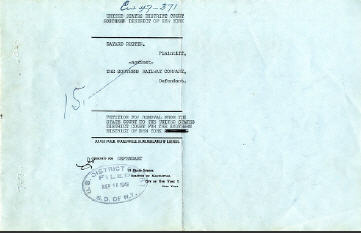
Bayard Rustin: Railroad to the Freedom Rides
Bayard Rustin: Railroad to the Freedom Rides
Description
Though not as famous as the Freedom Rides of the 1960s, many civil rights activists were testing the same racial boundaries in the 1940s. Though Bayard Rustin later became an organizer of the March on Washington and an advisor to Martin Luther King, Jr., on September 20th, 1947, he tried to gain entry into the dining car of a Southern Railway train. After being denied entry because of his race, Rustin decided to take Southern Railway to court to bring the issue of discrimination to light. Though not as famous as later events in the civil rights movement, the actions of activists like Bayard Rustin during the 1940s would prove influential to effecting true change.
Document
Discussion Questions:
- Starting on page five of the PDF, summarize the actions of Bayard Rustin?
- Based on the complaint, how does Rustin describe the motives of the Southern Railway employees
- Based on the complaint, how does Rustin believe his rights were violated?
- What type of tactics to Rustin use to create effective change? Do you think these tactics are the most successful? Why or why not?
- Compare his actions with earlier and later Civil Rights actions. What are the major similarities and differences?
Extension Activities
- Further Research: Using other National Archives resources, chart the development of Civil Rights for African-Americans on a timeline.
- Creative Writing: Write a journal from the perspective of Bayard Rustin describing his experiences during this time period.
- Create an Exhibit: Using the Bayard Rustin records available from the JFK Presidential Library and others, create a museum exhibit highlighting the record of this influential civil rights leader. Incorporate a variety of documents and text to tell his accomplishments.
Standards
National History Standards
- Era 9: Postwar United States (1945-1970s)
- Standard 4A: The student understands the "Second Reconstruction" and its advancement of civil rights.
NY Standards
- SS1.C.3. Study about the major social, political, economic, cultural, and religious developments in New York State and United States history involves learning about the important roles and contributions of individuals and groups.
- SS1.C.1. The study of New York State and United States history requires an analysis of the development of American culture, its diversity and multicultural context, and the ways people are unified by many values, practices, and traditions.
NJ Standards
- 6.1.12.D.13.a Determine the impetus for the Civil Rights Movement, and explain why national governmental actions were needed to ensure civil rights for African Americans.
If a teacher finds unique and effective ways to use these documents in their classroom and would like to share them with other teachers, please contact education@nara.gov.
